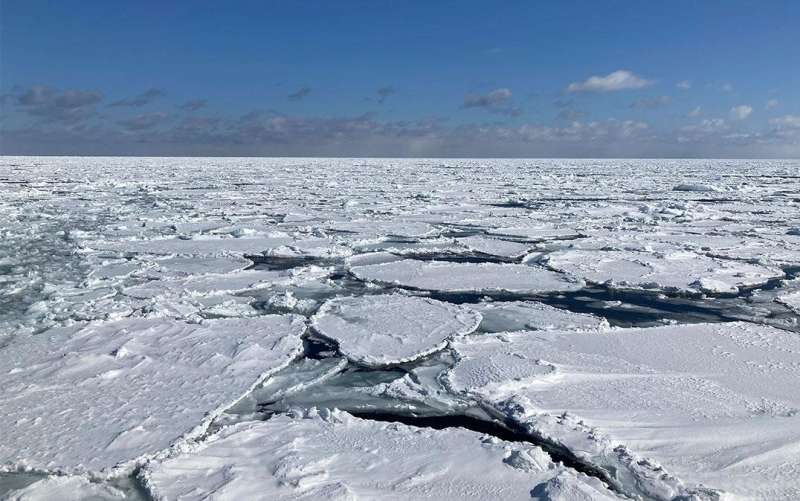This article has been reviewed according to Science X's editorial process and policies. Editors have highlighted the following attributes while ensuring the content's credibility:
fact-checked
trusted source
proofread
Annual changes in sea ice linked to ocean-atmosphere interactions

The Okhotsk Sea in the western Pacific Ocean, surrounded by Russia and Japan, is the southernmost sea in the world to freeze seasonally. The northwestern part of this shallow sea is an active sea-ice production area, but why the extent of sea ice varies year to year has remained a mystery.
In a study recently published in Atmosphere-Ocean, researchers from the University of Tsukuba revealed that these interannual variations are associated with ocean-atmosphere dynamics.
"In general, freezing starts in late fall, peaks from late February to early March, and the ice melts by June," explains lead author Professor Hiroaki Ueda. "But there are clear differences in the extent of sea ice between years."
Sea ice in the Okhotsk Sea is influenced by a number of factors, including regional cold air masses and low-pressure systems, as well as large-scale systems such as the Pacific-North American Pattern associated with the El Niño/Southern Oscillation (ENSO). Long-term changes in sea ice have also been observed as a result of climate change. A decrease in the extent of sea ice, about -9% per decade, was observed between 1979 and 2010, the second-highest rate of decline in the northern hemisphere.
"We wanted to get a better understanding of the processes involved in seasonal sea ice formation in the area," says co-author Professor Humio Mitsudera of the Institute of Low Temperature Science, Hokkaido University. "By examining interannual variations in sea ice over a long period of time and what drives them, we can form better long-term projections."
The researchers used satellite images of sea ice from 1971 to 2018 and analyzed patterns in the ice extent in relation to atmospheric variables such as cold air masses, extra-tropical cyclones, and atmosphere-ocean heat exchange.
At its greatest extent, the sea ice covered 90% of the sea. Generally, years could be classified as heavy or light sea-ice years. In heavy-ice years, there was a deepening of the Aleutian low (a semi-permanent, low-pressure system) and an accumulation of cold air. In light sea-ice years, southeasterly winds and warm air advection were associated with increases in extra-tropical cyclones off the Kamchatka Peninsula. There was also a weakening of the Aleutian low. These seasonal and annual changes in sea ice indicate that there may be a positive-feedback process between cold air masses associated with sea-ice anomalies and the Aleutian low.
"It appears that the sea ice has an insulating effect, which limits heat exchange between the atmosphere and the warmer ocean," explains Professor Mitsudera. "This insulating effect may play a role in the accumulation of cold air."
The tropical ocean also has a remote effect as anticyclonic anomalies that dominate in the Okhotsk Sea during light sea-ice years are closely associated with the propagation of a stationary Rossby wave. The wave is anchored by intensified convection in the vicinity of the South China Sea related to La Niña-like warm sea surface temperature anomalies.
While the study has highlighted some of the key processes at play in the Okhotsk Sea, further field studies are needed to gain a deeper understanding of how sea ice is likely to change in relation to shifting ocean-atmosphere dynamics.
More information: Hiroaki Ueda et al, Interannual Variations of Sea-ice Extent in the Okhotsk Sea—A Pan-Okhotsk Climate System Perspective, Atmosphere-Ocean (2023). DOI: 10.1080/07055900.2023.2175639
Provided by University of Tsukuba





















